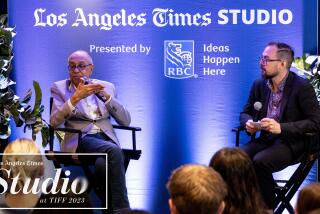GRIZZLY YEARS In Search of the American Wilderness <i> by Doug Peacock (Henry Holt: $19.95; 296 pp.) </i>
- Share via
Doug Peacock experienced just the kind of absurd Vietnam mishaps made legendary by filmmakers such as Oliver Stone: One day, he tried to keep his commander alive while American helicopters mistakenly rained bombs from above; the next, he watched his entire platoon fire rounds at an unarmed, but “suspicious” 10-year-old. No wonder, then, that his behavior after the war also fit the filmic part: He blasted down a phone booth with shotgun salvos when it guzzled his last bit of change; left for a camping trip after packing all the necessary gear (a .22 magnum derringer, .357 and .44 magnum Ruger single-action handguns, a bolt-action rifle and 12-gauge double-barreled shotgun); and found it easier talking with bears than with priests.
During one of these “conversations,” however, Peacock finally began to regain some peace. While a grizzly he had met on a park trail was “gnashing his jaws and lowering his ears,” the former green beret, deciding that his “shooting days were over,” lowered his pistol. “I felt something pass between us. The grizzly slowly turned away from me with grace and dignity and swung into the timber at the end of the meadow.”
The experience distanced him from the mentality he had assumed during the war by helping him realize that deciding not to attack--despite inner fears or officers’ orders--could be as much a sign of strength as attacking. “The grizzly radiated potency,” Peacock explains. “He carried the physical strength and thorniness of disposition that allowed him to attack or kill most any time he cared. But, almost always, he chose not to. That was power beyond a bully’s swaggering. It was a kind of restraint that commands awe--a muscular act of grace.”
“Grizzly Years” is particularly compelling, though, because it is not the simple story of a man rediscovering serenity amid nature. In fact, Peacock seems to spend most of his time seeking out grizzlies because they are the one truly threatening creature in the forest. As with other rebels, from T. E. Lawrence to Hunter S. Thompson, Peacock lives on the edge of death because doing so sharpens the dimensions of life.
By book’s end, Peacock never manages to reestablish the ordinary social ties he lost during the war. He breaks up with his girlfriend even though they recently have had a child and remains in touch only with those who take a deliberate stand counter to the culture: solitary outlaws such as novelist Edward Abbey (who modeled the character George Hayduke on Peacock) and a biologist who, according to his boss, “ ‘lacked sensitivity in dealing with public-relations situations.’ This meant that he had tried to bite a journalist from People Magazine.”
But loneliness is apparently the price Peacock has paid for the realization that the war he fought was not his own. It’s a process of rebellion that seems to have begun when he crawled deep into a Viet Cong tunnel, passing rooms filled with corpses before hearing some live breathing. When he left the tunnel, his fellow soldiers asked him whether it was worth bombing. “I told them I had not found anything down there,” Peacock replied, “that the tunnel was cold.”
More to Read
Only good movies
Get the Indie Focus newsletter, Mark Olsen's weekly guide to the world of cinema.
You may occasionally receive promotional content from the Los Angeles Times.










